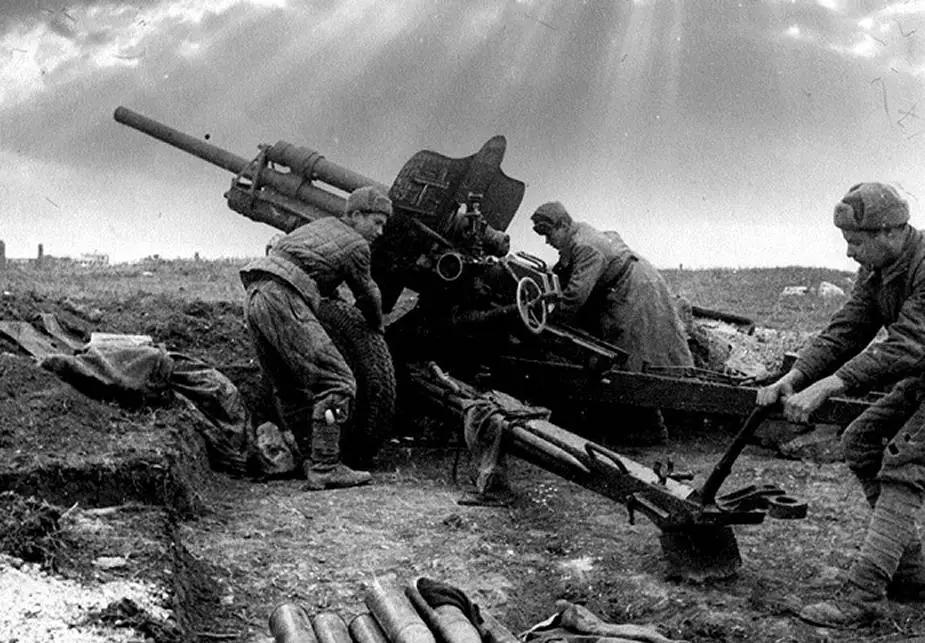Design and production of munitions are priority for Russian armed forces - Part 1
Effective engagement of the payload is the main military-technical task in any conflict of various intensity. It is also necessary to increase the number of munitions and maintain them in the required engagement readiness according to the number of launchers. The might of the Russian armed forces is determined by the latest weapons and hardware and the ability of the defense industry to design and produce modern munitions, PhD Technical Science V. Selivanov, PhD Technical Science V. Veldanov, and PhD Technical Science retired Colonel Yu. Ilyin write in the Voennaya Mysl (Military Thought) journal.
Follow Army Recognition on Google News at this link

The supremacy of Soviet artillery was a key factor of the success of the Stalingrad battle. During the war, close to 50 percent of metal supplied to the Soviet army from local origin and U.S. origin (Lend-Lease Act) was used to produce munitions (Picture source : Russian Seven)
The armies of the potential adversary also pay attention to the design, upgrade, production and engagement of munitions. The United States plans to buy Soviet-made munitions with corresponding weapons, which are used by many countries without a Russian license.
The munitions are necessary for the Department of Defense and other organizations, as well as allies to tests and trials, and combat engagement. It is planned to sign a five-year contract with several suppliers to procure and deliver munitions to the continental USA and outside it. In May 2019, the Pentagon announced plans to buy munitions for Russian and Soviet weapons. The contract envisaged supplies outside the USA as well.
Russia has always paid specific attention to the creation of new-generation munitions and the development of munitions industry. Without it, there were losses and catastrophes. In 1905, Russia lost a war to Japan mostly because of a lack of munitions. Unfortunately, the lesson was not learned. In the beginning of the Great Patriotic War, the same reason allowed the Nazi troops to approach Moscow. In 1941, the Red Army had sufficient weapons, but lacked munitions (cartridges and artillery shells). There was a norm of three shells per day for a gun. The German Luftwaffe (air force) destroyed ammunition dumps in the first days of the war and 40 percent of the manufacturing plants were in the occupied territory.
In the first half of 1943, the industry produced everything necessary for the army and navy. The supremacy of Soviet artillery was a key factor of the success of the Stalingrad battle. It was the breakthrough in the war. During the war, close to 50 percent of metal supplied to the Soviet army from local origin and U.S. origin (Lend-Lease Act) was used to produce munitions. They swallowed close to half of defense appropriations.
Gunpowder production determined the general state of the munitions industry. The Soviet government decided in January 1939 to create the Ministry of Munitions. After the war and up to 1985, the munitions of the army and navy were replenished 3-4 times, specifically under Defense Minister Dmitry Ustinov. The country created such a potential of the munitions industry that NATO had to catch up.
Over a dozen ministries operated for the defense industry. Three-fourth of all Soviet R&D were related to defense. Research specialists were trained and the best of them were sent to design bureaus and research organizations of the military-industrial complex. It created a mighty defense industry and ensured military-strategic parity with the USA.
In post-Soviet period, the potential was lost. In 1990s, the workforce in the military-industrial complex reduced several times from ten million people (in the USSR) to 2.5 million (in Russia). The number of R&D radically decreased, as well as procurement orders for batch production of military products.
In Soviet time, it was banned to procure foreign components of munitions and equipment for the defense industry. Each enterprise had a workshop of non-standard equipment, which employed close to 500 people. They designed and created all the necessary technological tools. Imports of technologies create dependence on foreign supplies, which is fraught with dangerous consequences. It now happens with supplies of foreign digital tools and high-tech equipment. The Soviet experience has not been learned in full.
© Copyright 2021 TASS / Army Recognition Group SPRL . All rights reserved. This material may not be published, broadcast, rewritten or redistributed.


























